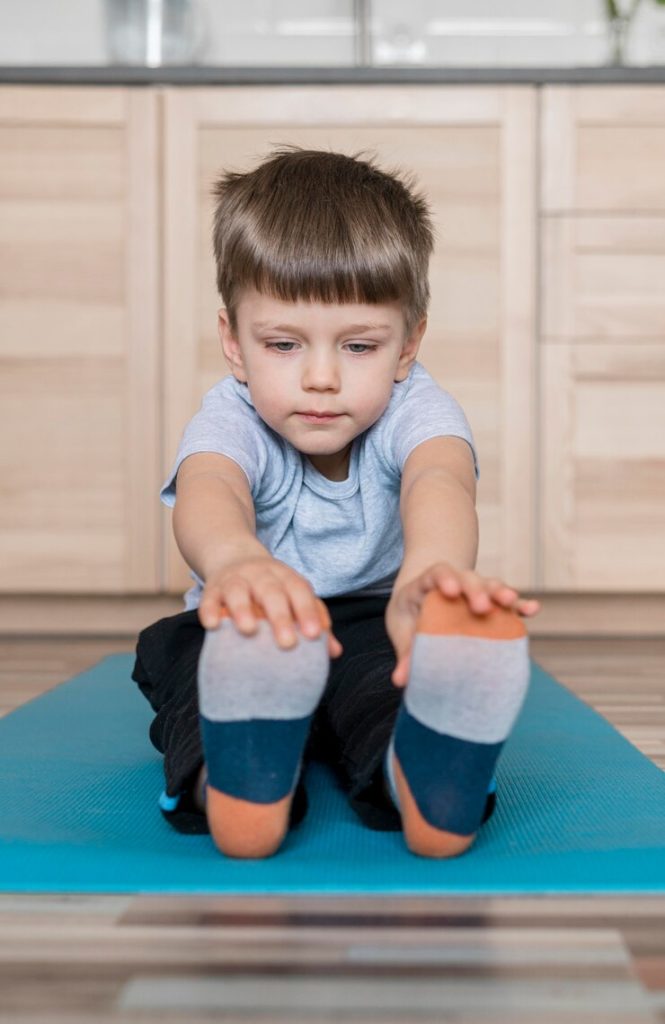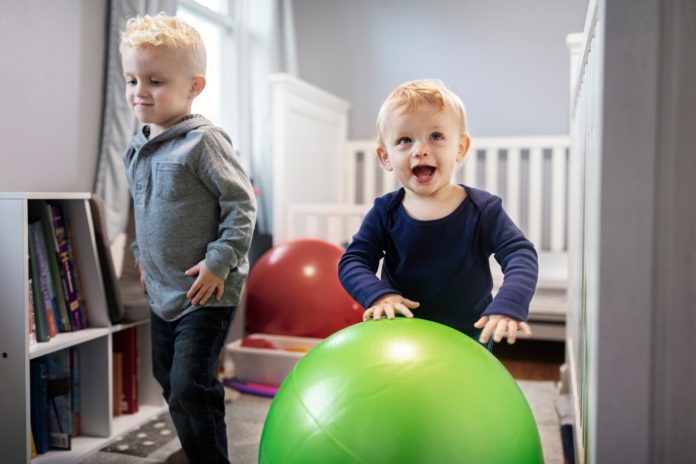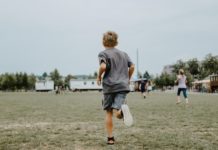Exercise is crucial for all kids, but particularly at nursery in Govan age, when children must adapt to a new environment while simultaneously developing cognitive and motor abilities.
Exercises for kids

Warming up is a crucial part of any physical activity, especially for young children, whose muscles and joints are still developing. For little ones, warm-up exercises should be simple, engaging, and fun, designed to gently prepare their bodies for more vigorous activities. Ideal warm-ups for young kids might include playful stretches like pretending to be animals stretching in the morning or imaginative games like “Simon Says,” focusing on gentle movements such as arm circles, toe touches, and marching in place. These activities not only help to increase blood flow and muscle temperature but also enhance their coordination and motor skills. The key is to keep these exercises light-hearted and inclusive, ensuring every child feels comfortable and excited to participate and setting a positive tone for the rest of the physical activity session.
The Best Exercises for Kids in the Nursery in Govan
Our table for Govan nursery exercises for kids offers a useful guide tailored for nurseries in the Govan area, introducing the perfect blend of fun and development for young minds. We meticulously choose each exercise to enhance physical, cognitive, and social growth in young children.
From circle time movement that encourages rhythm and social interaction to nature walks that connect little ones with the outdoors, this table provides a diverse range of activities suitable for various age groups. These exercises are not just about movement; they’re about nurturing a love for learning and exploration in a safe, engaging, and age-appropriate manner. Whether you’re a nursery professional or a parent, this guide is an invaluable resource for fostering holistic development in early childhood.
It’s important to tailor these activities to the specific needs and abilities of the children in your nursery. Always prioritise safety and fun in equal measure. This table can be a starting point for nurseries to design a comprehensive physical activity programme that aligns with early childhood learning frameworks in the UK.
| Exercise Type | Description | Key Benefits | Age Group | Duration | Equipment Needed |
|---|---|---|---|---|---|
| Circle Time Movement is a fun and engaging activity that promotes physical movement and social interaction. | Group activity involving singing and simple movements (clapping, stomping) | enhances coordination, rhythm, and social interaction | 2-4 years | 10-15 min | None |
| Obstacle Courses | Customisable courses using soft play equipment | Developing motor skills, balance, and problem-solving abilities | 3-5 years | 15-20 min | Soft mats, tunnels, and cones |
| Storytime Yoga | Combining storytelling with basic yoga poses | promotes flexibility, concentration, and relaxation. | 2-5 years | 10-15 min | Yoga mats, storybooks |
| Sensory Play | Activities using different textures and materials | stimulates sensory development and creativity. | 1-3 years | Flexible | Various textures (fabric, foam, etc.) |
| Creative Dance | Freestyle movement to music | encourages expression, rhythm, and physical fitness | 3-5 years | 15-20 min | music player, open space |
| Nature Walks | Supervised walks in a safe outdoor environment | connects children with nature and enhances observation skills. | 3-5 years | 20-30 min | Appropriate outdoor clothing |
| Parachute Games | Play group games using a large parachute. | builds teamwork, coordination, and gross motor skills | 2-5 years | 10-15 min | Large parachute |
Nursery PE Games Without Equipment
Outdoor PE games don’t always need equipment; some newer nursery PE games may provide more fun ways of developing physical endurance, strength, balance, coordination, and mindfulness.
Students split up into pairs for this game and follow the teacher’s instructions, such as ‘front to front’ or’shoulder to shoulder’ commands that require linking arms with their partner each time she calls out these instructions.
Duck, Dusk, Goose
A classic nursery in Govan game for PE could be simple but fun. The duck, duck, goose game allows children to develop listening skills. Children sit in a circle with one child designated “it,” who then moves around outside of it, tapping each other on the head and saying either “duck” or “goose” each time they tap someone. If one child is tagged as a goose, they chase after “it” until they tag “it” and become “it” for the next round. After successfully being tagged as a goose, that person becomes it and takes their place.
There are over 1000 cosmetics to unlock, including hats, costumes, pets, death stingers, and player banners! Complete tasks and achieve benchmarks to gain access. Play in both public and private game lobbies featuring voice chat.
Wheelbarrow Race
The Wheelbarrow Race is an ancient game that first originated at fairs and carnivals before making its way into nursery schools. Children work together in pairs to compete in this fun nursery pe game; one child becomes the “wheelbarrow,” walking on their hands while their partner “drives” them towards the finish line.
This game is easy to set up and play indoors or outdoors, and it will have kids laughing as they race towards the end of the course. Plus, it teaches children teamwork!
Split your students into pairs and assign each of them a captain. The captains take turns running to both the left (port) and right (starboard) sides of the room, touching freedom cones or walls along their route. They are then tagged by captors, who must send players to jail. However, those who are tagged may be released by throwing balls from the sidelines within their pair. The first team to complete this fun relay race will win. Announce the winners at the finish line and reward them with treats if desired. This game is ideal for field day or camp games!
Star Wars: Lightsaber Tag
This nursery rhyme game allows kids to demonstrate the power of The Force as they try to tag one another with pool noodles cut in half. The student designated as “It” can launch lightsabers at any tagged student, who then forms an invisible bridge with another student until someone crawls under it to free them.
Once the Empire hears of rebel activity, they send in stormtroopers to deal with it. Select 2-3 students as stormtroopers by selecting a white pinnie and a yellow blaster (hula hoop). Make tags by kicking the blaster so it slides along the floor and touches someone from the rebel force; once tagged, students become frozen but can unfreeze themselves by tapping their Lightsaber against the floor.
Imperial forces then summon Darth Vader, their most fearsome leader. Select one student to play as Darth Vader; this person should wear black attire and carry a red blaster (hula hoop). All other students must avoid being hit by Vader’s blaster or they will become frozen. To unfreeze themselves, quickly tap your Lightsaber against the ground!
Other Exercises
Exercise for the nursery should be engaging activities that help kids use up excess energy while learning valuable life lessons. Exercise may include simple things such as hopping or dancing to music.
Grasping Exercises
Most babies have an automatic grasp reflex, in which their hand automatically grips when placed upon something. Over time, babies can develop a functional grip that is essential for picking things up, zipping zippers, buttoning shirts, drawing, and writing.
Consider placing tape of different lengths on the floor and encouraging your child to peel it. This activity strengthens their hands and fingers while developing their visual and perceptual skills. Also, try hanging toys or bells near them that encourage them to reach for them!
Crawling Exercises
Babies may make moving on all fours appear effortless, but their tiny muscles work hard to push with their legs and pull with their arms while simultaneously maintaining balance through wiggling hips and trunks. These movements give a full-body workout that burns fat and strengthens muscles.
Help your baby prepare to crawl by placing toys just out of reach on the floor to encourage scooting towards them. Also, try encouraging side-to-side movement by placing toys in safe spots on the floor so they can pivot around safely while playing.
Bear crawls and crab walks provide your baby with an ideal transitional exercise, strengthening both chest and arm muscles simultaneously. Once your baby becomes proficient at crawling, introduce bear crawls or crab walks as warm-up exercises; just like baby crawls, they can be performed anywhere!
Stretching Exercises
Stretching helps kids move more freely and reduces the risk of muscle strain. They can perform simple exercises like crossbody shoulder, toe touch stretch, camel pose, or dynamic stretching before sports or other physical activities.
Perform stretches after completing an effective warm-up, such as walking or jogging, to gradually raise the heart rate for 10 to 15 minutes. A good warm-up will increase blood flow to muscles, making stretching easier while decreasing the risk of injury.
Exercises that include singing help children focus and expend energy more efficiently, with classic songs like “If You’re Happy and You Know It” or “Head, Shoulders, Knees, and Toes” serving to build gross motor skills while being fun to do. Freeze dance can also provide a fun way of combining aerobic movement with music to improve balance and coordination while improving gross motor development.
Sit-Ups
At this stage, babies are learning to use their arms as support while sitting up. However, it is important not to overlook this milestone in development, even though babies may rock back and forth while using this tripod-like position and often topple over.
Once they can do a full sit-up, cycling their legs up and down, similar to pedalling on a bicycle, is an excellent way to strengthen hip, back, and core muscles as well as improve flexibility.
Your baby will find this activity entertaining, often smiling or cooing as their legs cycle back and forth. Play a song together like “If You’re Happy and You Know It” or “Head, Shoulders, Knees, and Toes.” Doing this activity together will help your child focus their attention while having fun and building strength.
Cycling Exercises
Cycling exercises in the nursery are a fun and engaging way to burn off energy and help children develop balance, strength, and coordination. Children can choose trikes or traditional bikes equipped with training wheels to pedal on to gradually build endurance over time.
Learning to ride a bicycle requires practice and concentration, making a safe environment with limited traffic an essential factor for proper cycle training. At first, children may need some guidance on how to ride an adult-sized bicycle but eventually their skills should come naturally and safely, without worry from other riders or obstacles in the way.
At first, toddlers can start by cycling their feet up and down in an imitation of pedalling a bicycle; this exercise helps develop their calf and thigh muscles, while eventually they may learn to do this with both arms at once! Once this technique becomes independent enough for their toddler, practice should continue regularly in order to develop coordination.
Lifting Exercises
As kids get older, they become able to learn to lift objects, which is an essential developmental exercise that strengthens arms and shoulders. You may begin with small toys like rattles or anything in their environment; usually around 3 or 4 months, placing these objects directly in front of them as they sit in a high chair or bouncy seat can encourage this skill development.
As they become stronger, they should advance to bench step-ups, where one foot moves forward in a large step before lowering into a lunge position and taking another large step forward, ideally doing several reps at a time before building up to more as their muscles gain strength.
Contrary to adults, when training children, they don’t need to reach muscular failure; rather, they should always be able to complete their exercises without excessive struggle and full control over movement. Depending on the activity involved, it may also be beneficial to take short rest breaks between sets.




